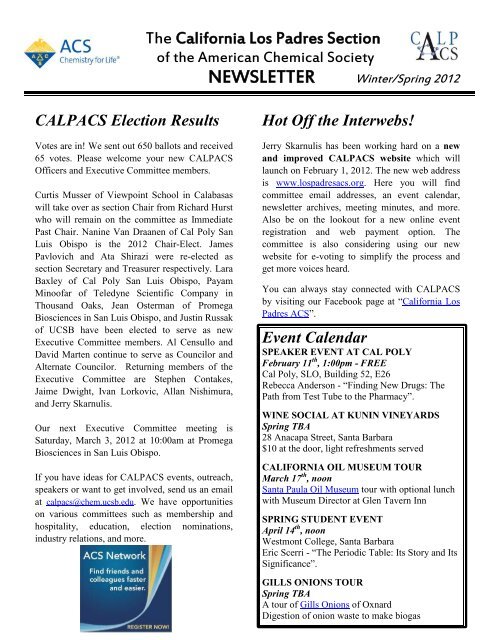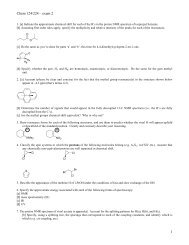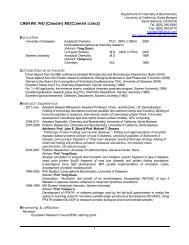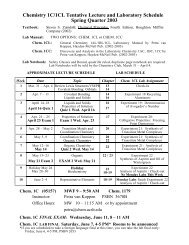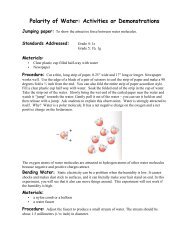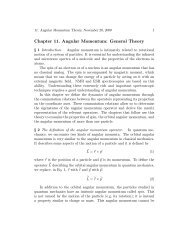Newsletter - Winter 2012 - Department of Chemistry and Biochemistry
Newsletter - Winter 2012 - Department of Chemistry and Biochemistry
Newsletter - Winter 2012 - Department of Chemistry and Biochemistry
Create successful ePaper yourself
Turn your PDF publications into a flip-book with our unique Google optimized e-Paper software.
The California Los Padres Section<strong>of</strong> the American Chemical SocietyNEWSLETTER <strong>Winter</strong>/Spring <strong>2012</strong>CALPACS Election ResultsVotes are in! We sent out 650 ballots <strong>and</strong> received65 votes. Please welcome your new CALPACSOfficers <strong>and</strong> Executive Committee members.Curtis Musser <strong>of</strong> Viewpoint School in Calabasaswill take over as section Chair from Richard Hurstwho will remain on the committee as ImmediatePast Chair. Nanine Van Draanen <strong>of</strong> Cal Poly SanLuis Obispo is the <strong>2012</strong> Chair-Elect. JamesPavlovich <strong>and</strong> Ata Shirazi were re-elected assection Secretary <strong>and</strong> Treasurer respectively. LaraBaxley <strong>of</strong> Cal Poly San Luis Obispo, PayamMino<strong>of</strong>ar <strong>of</strong> Teledyne Scientific Company inThous<strong>and</strong> Oaks, Jean Osterman <strong>of</strong> PromegaBiosciences in San Luis Obispo, <strong>and</strong> Justin Russak<strong>of</strong> UCSB have been elected to serve as newExecutive Committee members. Al Censullo <strong>and</strong>David Marten continue to serve as Councilor <strong>and</strong>Alternate Councilor. Returning members <strong>of</strong> theExecutive Committee are Stephen Contakes,Jaime Dwight, Ivan Lorkovic, Allan Nishimura,<strong>and</strong> Jerry Skarnulis.Our next Executive Committee meeting isSaturday, March 3, <strong>2012</strong> at 10:00am at PromegaBiosciences in San Luis Obispo.If you have ideas for CALPACS events, outreach,speakers or want to get involved, send us an emailat calpacs@chem.ucsb.edu. We have opportunitieson various committees such as membership <strong>and</strong>hospitality, education, election nominations,industry relations, <strong>and</strong> more.Hot Off the Interwebs!Jerry Skarnulis has been working hard on a new<strong>and</strong> improved CALPACS website which willlaunch on February 1, <strong>2012</strong>. The new web addressis www.lospadresacs.org. Here you will findcommittee email addresses, an event calendar,newsletter archives, meeting minutes, <strong>and</strong> more.Also be on the lookout for a new online eventregistration <strong>and</strong> web payment option. Thecommittee is also considering using our newwebsite for e-voting to simplify the process <strong>and</strong>get more voices heard.You can always stay connected with CALPACSby visiting our Facebook page at “California LosPadres ACS”.Event CalendarSPEAKER EVENT AT CAL POLYFebruary 11 th , 1:00pm - FREECal Poly, SLO, Building 52, E26Rebecca Anderson - “Finding New Drugs: ThePath from Test Tube to the Pharmacy”.WINE SOCIAL AT KUNIN VINEYARDSSpring TBA28 Anacapa Street, Santa Barbara$10 at the door, light refreshments servedCALIFORNIA OIL MUSEUM TOURMarch 17 th , noonSanta Paula Oil Museum tour with optional lunchwith Museum Director at Glen Tavern InnSPRING STUDENT EVENTApril 14 th , noonWestmont College, Santa BarbaraEric Scerri - “The Periodic Table: Its Story <strong>and</strong> ItsSignificance”.GILLS ONIONS TOURSpring TBAA tour <strong>of</strong> Gills Onions <strong>of</strong> OxnardDigestion <strong>of</strong> onion waste to make biogas
Finding New Drugs: ThePath from Test Tube to thePharmacy A CALPACS speaker eventCurrent industry statistics estimate that it takesfifteen years <strong>and</strong> nearly $1 billion to bring a newdrug to market, but most consumers are unaware –<strong>and</strong> even skeptical – <strong>of</strong> the extensive effortsinvolved in finding <strong>and</strong> successfully developingthese products. This presentation looks inside theblack box, sharing an insider’s view <strong>of</strong>pharmaceutical research <strong>and</strong> development <strong>and</strong>answering several commonly asked questions:Where does a chemist get ideas for synthesizing<strong>and</strong> innovative drug? Why are animals still used indrug research? Why can’t scientists <strong>and</strong> clinicianswork faster? And why can’t they do their jobbetter <strong>and</strong> cheaper? In the course <strong>of</strong> describing thedrug development activities, this presentation willhighlight the range <strong>of</strong> chemistry subspecialtiesemployed in moving a drug from the lab bench tothe pharmacy shelf.***Rebecca Anderson has worked in thebiopharmaceutical industry from more than 25years in jobs spanning pharmaceuticals,biotechnology, medical devices, <strong>and</strong> contractresearch organizations. She holds a BA degree inchemistry from Coe College <strong>and</strong> a Ph.D. inpharmacology from Georgetown University.Following postdoctoral training at the University<strong>of</strong> Toronto, she held academic appointments at theGeorge Washington University Medical Center<strong>and</strong> the University <strong>of</strong> Michigan School <strong>of</strong> PublicHealth. She subsequently held positions <strong>of</strong>increasing responsibility in pharmaceutical R&Dat Parke-Davis & Company, Boehringer IngelheimPharmaceuticals, Miravant Pharmaceuticals, <strong>and</strong>Amgen. Dr. Anderson currently works as afreelance technical writer <strong>and</strong> is the author <strong>of</strong>Career Opportunities in Clinical Drug Research.California Oil MuseumA CALPACS tour eventThe California Oil Museum in Santa Paula is anhistoric building in that it was the birthplace, inthe 1890s, <strong>of</strong> the Union Oil Company(UNOCAL). Prior to UNOCAL's deeding thebuilding over to the City <strong>of</strong> Santa Paula, the oilcompany invested millions <strong>of</strong> dollars to refurbishthe second floor <strong>of</strong> the building. The purpose <strong>of</strong>the remodeling was to resurrect the appearance<strong>and</strong> facilities <strong>of</strong> the oil company as it was in the1890s. Visitors to the museum can view geologic<strong>and</strong> petroleum-related exhibits on the first floorthat includes a full-scale model <strong>of</strong> a 19th Centuryoil rig, as well as rotating exhibits that range fromart to scientific innovation. From the st<strong>and</strong>point<strong>of</strong> our discipline, chemistry, the area is also uniquein that it was one <strong>of</strong> the first areas wherepetroleum was not only discovered in California,but also refined to produce many <strong>of</strong> the numeroushydrocarbon products derived from crudeoil. Although <strong>of</strong>f the beaten track, the museum iswell worth a visit given its significance to thepetroleum <strong>and</strong> chemical engineering industries inCalifornia.CALPACS will be hosting a tour <strong>of</strong> the OilMuseum on March 17 th after an optional lunchwith the Director at nearby Glen Tavern Inn.Please stay tuned for the event flier for details.On February 11 th , Rebecca Anderson will begiving a free lecture at Cal Poly State Universityin San Luis Obispo. There will also be a booksigning with books for sale after the talk <strong>and</strong> lightrefreshments will be served.
The Periodic Table: Its Story<strong>and</strong> Its SignificanceA CALPACS student eventEric Scerri received all <strong>of</strong> his education in the UKat the universities <strong>of</strong> Cambridge, Southampton <strong>and</strong>King’s College, London. He has been a Lecturerin <strong>Chemistry</strong> <strong>and</strong> History & Philosophy <strong>of</strong> Scienceat the University <strong>of</strong> California at Los Angeles(UCLA) for the past twelve years. He is theauthor <strong>of</strong> the definitive book on the periodic table,The Periodic Table: Its Story <strong>and</strong> Its Significance,Oxford University Press, 2007 as well as <strong>of</strong>Collected Papers in Philosophy <strong>of</strong> <strong>Chemistry</strong>, <strong>and</strong>Selected Papers on the Periodic Table, publishedby Imperial College Press in 2008 <strong>and</strong> 2009respectively. Scerri has written over 150 articlesin journals <strong>and</strong> edited collections in chemistry,chemical education <strong>and</strong> history <strong>and</strong> philosophy <strong>of</strong>science.<strong>Chemistry</strong> Olympiad <strong>2012</strong>An invitation to participate in the <strong>2012</strong> USNational <strong>Chemistry</strong> Olympiad (USNCO) was sentto 70 High School chemistry teachers <strong>and</strong>administrators. The USNCO program seeks tostimulate interest in chemistry among high schoolstudents <strong>and</strong> recognize outst<strong>and</strong>ing youngchemistry students, teachers, <strong>and</strong> schools. UScitizens competing in the USNCO are eligible tobe selected as members <strong>of</strong> the US team for theInternational <strong>Chemistry</strong> Olympiad. For the past27 years, the United States has sent a team <strong>of</strong> fourstudents to compete with nations around theworld. The students participate in both theoretical<strong>and</strong> laboratory examinations over several days <strong>and</strong>gold, silver, <strong>and</strong> bronze medals are awarded to thebest performers.This year, the international event will be held inWashington, DC, on July 21-30. To identifypotential c<strong>and</strong>idates for the four-member US team,CALPACS is conducting a preliminary screeningthrough a local exam that will be administered tostudents at their local High School. The top 10scoring students on the local exam will be invitedto take the national exam at Westmont College inApril where they will have a chance to qualify forone <strong>of</strong> 20 spots at the USNCO study camp whereHis most recent book is called A Very ShortIntroduction to the Periodic Table, has just beenpublished by Oxford University Press.Eric Scerri will be speaking on the periodic tableat our spring student event which will be held atWestmont College on Saturday, April 14 th .Stay tuned for details.they will compete for one <strong>of</strong> four spots on the U.S.team.As part <strong>of</strong> our support for the 2011 USNCO,CALPACS will provide participating High Schoolteachers with an award in the form <strong>of</strong> a 1-yearsubscription to Chem13News or a 1-yearextension to their current subscription toChem13News. The magazine subscription has theadvantage <strong>of</strong> promoting pr<strong>of</strong>essional excellence inHigh School <strong>Chemistry</strong> teaching throughout oursection.Earth Day <strong>2012</strong>CALPACS is planning to hold a table at the SantaBarbara Earth Day Festival again this year. Lastyear, fellow ACS members <strong>and</strong> the WestmontCollege <strong>Chemistry</strong> Club discussed greenchemistry with members <strong>of</strong> the public <strong>and</strong> h<strong>and</strong>edout promotional materials, including coastersmade from recycled PET <strong>and</strong> denim, <strong>and</strong>environmentally-friendly thermochromic pens.If you would like to help with the Earth Day eventthis year, please contact Stephen Contakes atscontakes@westmont.edu.
Fall Luncheon 2011Honoring our Fifty Year Members – by DavidMartenThis year, our 50 year member luncheon was heldat Stella Mare Restaurant near the Bird Refuge inSanta Barbara on Saturday, October 22 nd . One <strong>of</strong>our new 50 year members, Dr. J. Thomas Gerigfrom U.C. Santa Barbara, gave an inspiring talk onhis research entitled: “Underst<strong>and</strong>ing Peptide-Solvent Interactions through NMR <strong>and</strong> MD”.There were about 33 who attended <strong>and</strong> we enjoyeda wonderful lunch <strong>of</strong> either roasted chicken breastor Penne pasta with artichoke hearts, mushrooms<strong>and</strong> tomatoes. Several others with more than 50years in the ACS were there plus a couple with 60years as a member.The talk focused on using molecular dynamicscalculations to model what is being observed inthe NMR spectrum <strong>of</strong> a small protein, [val5]-angiotensin, in a solvent mixture <strong>of</strong> methanol <strong>and</strong>water. Scientists <strong>of</strong>ten study proteins in thesemixed solvent systems <strong>and</strong> the intent is to be ableto use NMR nuclear Overhauser measurements onproteins to determine solvent-protein interactions.Due to the complexity <strong>of</strong> the systems, moleculardynamics calculations are required to helpunderst<strong>and</strong> the experiment data. Dr. Gerigreported his recent findings <strong>and</strong> gave details <strong>of</strong> thepeptide-solvent interactions that he has observed<strong>and</strong> interpreted.Chair-Elect Curtis Musser, Dr. Gerig <strong>and</strong> DavidMartenGills OnionsA CALPACS tour eventLocated in Oxnard, Gills Onions is one <strong>of</strong> thelargest fresh-cut onion processing plants in theworld. But Gills doesn’t just process onions, theyutilize an Advanced Energy Recovery System(AERS) on the property that turns the onion wasteinto biogas, which feeds into fuel cells to produceultra-clean heat <strong>and</strong> power. In 2010, PrudentEnergy announced the installation <strong>of</strong> a 600-kilowatt Vanadium Redox Battery Energy StorageSystem (VRB-ESS) at Gills Onions to enhancetheir existing AERS. The VRB-ESS will providethe facility with emergency backup power <strong>and</strong>reduce the company’s need to draw electricityfrom the grid when rates are highest. Gills expectsto save hundreds <strong>of</strong> thous<strong>and</strong>s <strong>of</strong> dollars each yearin operating expenses.Keep your ears open for a weekday tour date inMay or June!ACS National Meeting<strong>Chemistry</strong> <strong>of</strong> LifeSan Diego, CA March 25-29 Chemical Networks in Biology Epigenetics: From Basic Principlesto Drug Development Materials as Medicines Drug Polypharmacology Prediction<strong>and</strong> Design Protein Conjugates: From BasicPrinciples to Clinically Active DrugsThe Kavli Foundation Innovations in<strong>Chemistry</strong> LectureMonday, March 26, 5:30-6:30Speaker: Carolyn Bertozzi <strong>of</strong> University <strong>of</strong>California, Berkeley & San Francisco HowardHughes Medical InstituteREGISTER ONLINE
Annual CALPACS Wine Tasting Event 2011Mosby Winery <strong>and</strong> Vineyards – by Payam Mino<strong>of</strong>ar<strong>Chemistry</strong> is the science <strong>of</strong> transformation, <strong>and</strong>oenology is one <strong>of</strong> its earliest forms. As chemistswe may wonder which transformation is morepr<strong>of</strong>ound: the transformation from squashedgrapes to an alcoholic elixir, or the one from a sadmood to a state <strong>of</strong> ecstasy.The winemaker <strong>and</strong> owner, Bill Mosby, showedup <strong>and</strong> entertained numerous questions about hiscareer as a periodontist, his early career as abrewer in his college dormitory, his retirement to anew career as a winemaker <strong>and</strong>, <strong>of</strong> course, the wayhe makes his wines. Unfortunately, legalrestrictions proscribed the pouring <strong>of</strong> br<strong>and</strong>ies thathe had begun to distill on the property, but thathad no negative impact on the mood <strong>of</strong> theattendees.No one really pondered that deep philosophicalquestion at Mosby Winery <strong>and</strong> Vineyards onDecember, 10, 2011. We celebrated the fabulouselixirs fermented by Bill Mosby. The fullcontingent <strong>of</strong> chemists who descended uponBuellton on a sunny, cool autumn day were treatedto a wonderful tasting <strong>of</strong> many Italian varieties <strong>of</strong>wine, an assortment <strong>of</strong> delicious cheeses <strong>and</strong>hearty soups prepared by members from San LuisObispo.Full attendance made the event a fantasticopportunity to meet chapter members from theextreme regions <strong>of</strong> the chapter's vast territory:from Thous<strong>and</strong> Oaks to San Luis Obispo. It was,therefore, just as fabulous a networkingopportunity as it was a way to spend a beautifulday.
No ACS chapter can claim these amazingprivileges that CALPACS members <strong>of</strong>ten take forgranted. So, don't miss the next opportunity tocelebrate your pr<strong>of</strong>ession by drinking one <strong>of</strong> itsearliest successes. Keep your eye out for the nextCALPACS event, <strong>and</strong> make your reservationsearly.Special thanks are extended to Nanine VanDraanen for organizing the event, <strong>and</strong> to James<strong>and</strong> Cathy Pavlovich, David <strong>and</strong> Ramona Marten,Jaime Dwight, <strong>and</strong> John Hagen for providing thedelicious spread.We celebrated last year's National <strong>Chemistry</strong>Week by holding a slime-making activity at thePaseo Nuevo mall on October 29th. ACS memberKristi Lazar, an Assistant Pr<strong>of</strong>essor <strong>of</strong> <strong>Chemistry</strong>at Westmont College, led this event. She wasassisted by Westmont <strong>Chemistry</strong> students.National <strong>Chemistry</strong> Week 2011Pictured from left: Nicole Grabe, Elizabeth Grossman,Kristi Lazar, Kylie Miller <strong>and</strong> Ryan Morgan.Kristi reported: "The students have told me howthankful that they were to be a part <strong>of</strong> this funday. We had a steady stream <strong>of</strong> kids visit ourtable to make slime <strong>and</strong> it was a beautiful day!"
We also held a liquid nitrogen ice cream demoevent at Hope Elementary school in SantaBarbara. Caleb Bos, Westmont College<strong>Chemistry</strong> Club president, <strong>and</strong> Ellen Brudi, aWestmont <strong>Chemistry</strong> student, visited HopeElementary <strong>and</strong> made liquid nitrogen ice creamfor approximately eighty 5th <strong>and</strong> 6th gradestudents. The kids enjoyed the demonstration <strong>and</strong>had many good questions about phases <strong>of</strong> matter<strong>and</strong> nitrogen.New Faculty HiresAlan L. Kiste completed aB.S. in <strong>Chemistry</strong> atCalvin College in Gr<strong>and</strong>Rapids, Michigan in1993. He earned an M.S. inMacromolecular Science <strong>and</strong>Engineering <strong>and</strong> an M.A. inEducation, both from theUniversity <strong>of</strong> Michigan inAnn Arbor.After teaching high school chemistry for severalyears, he returned to the University <strong>of</strong> Michiganwhere he earned a combined doctorate in<strong>Chemistry</strong> <strong>and</strong> Education while working withBrian Coppola <strong>and</strong> Joseph Krajcik. His researchinterests include the development <strong>of</strong> new methodsfor analyzing chemistry students' learning <strong>and</strong>production <strong>of</strong> chemistry symbolism <strong>and</strong>representations, <strong>and</strong> the analysis <strong>of</strong> studentrepresentations using these new methods, theexamination <strong>of</strong> how students utilize learningresources in large lecture classes, <strong>and</strong> thedevelopment, assessment, <strong>and</strong> evaluation <strong>of</strong> newpedagogical interventions. He joined the facultyin the <strong>Department</strong> <strong>of</strong> <strong>Chemistry</strong> <strong>and</strong> <strong>Biochemistry</strong>at Cal Poly in September 2011.Greg Scott is a native <strong>of</strong>eastern Kentucky <strong>and</strong>earned his B.S. inchemistry from DavidsonCollege in North Carolinain 2004. Subsequently, hejoined the corps <strong>of</strong> TeachFor America where hetaught high schoolchemistry <strong>and</strong> physics inBrownsville, TX for two years before pursuinggraduate studies in physical chemistry at theUniversity <strong>of</strong> Illinois at Urbana-Champaign. AtIllinois, Greg earned his Ph.D. under MartinGruebele, where he performed experimentalstudies <strong>of</strong> single-molecule optical absorption
detected by scanning tunneling microscopy <strong>and</strong>theoretical studies <strong>of</strong> protein folding potentialenergy surfaces.Greg joined the faculty <strong>of</strong> Cal Poly in the fall <strong>of</strong>2011 as an assistant pr<strong>of</strong>essor in the <strong>Department</strong><strong>of</strong> <strong>Chemistry</strong> <strong>and</strong> <strong>Biochemistry</strong> where he isteaching in the General <strong>Chemistry</strong> sequence. Heis passionate about chemical education, both inimproving learning outcomes for Cal Polystudents, but also in working toward achievingeducational equity through K-12 outreach. Greghas continued research interests in the optoelectronicproperties <strong>of</strong> local single-moleculechemistry as well as in the application <strong>of</strong>diffusional dynamics for low-barrier kinetics.Shanju Zhang is currentlyan assistant pr<strong>of</strong>essor <strong>of</strong>Polymers <strong>and</strong> Coatingsprogram in the <strong>Department</strong> <strong>of</strong><strong>Chemistry</strong> <strong>and</strong> <strong>Biochemistry</strong>at California Polytechnic StateUniversity San Luis Obispo.He received his B.Sc. inchemistry from JilinUniversity in 1993 <strong>and</strong> hisPh.D. in polymers from thesame university in 1998. In 1998-2000 he was anassistant pr<strong>of</strong>essor at Changchun Institute <strong>of</strong>Applied <strong>Chemistry</strong> at the Chinese Academy <strong>of</strong>Sciences. He received an Alex<strong>and</strong>er vonHumboldt fellowship at Technical University <strong>of</strong>Berlin in 2000-2002. He did his postdoctoralresearch at University <strong>of</strong> Cambridge in 2002-2006.Before he joined the faculty <strong>of</strong> Cal Poly in 2011,he was a research scientist at Georgia Institute <strong>of</strong>Technology (2006-2009) <strong>and</strong> Yale University(2009-2011). Dr. Zhang has published around 60papers in the peer-reviewed journals in the areas<strong>of</strong> synthesis, structure, processing <strong>and</strong> properties<strong>of</strong> polymers <strong>and</strong> liquid crystals. His currentresearch is focused on polymers <strong>and</strong> coatings withapplications in energy conversions, coveringconjugated polymers, semiconducting nanotubes/nanowires, <strong>and</strong> polymer nanocomposites.Michael Everest hasalways been fascinatedwith science. In high school,chemistry was the subjectthat tapped into thisfascination the most. It alsohelped that, compared to theway physics <strong>and</strong> biologywere taught, he could figurethings out on a chemistryexam without having verymuch information committed to memory. Hecontinued his interest in chemistry by completingthe ACS-certified B.S. at Wheaton College(Wheaton, IL). At that time, he decided thatteaching chemistry at a primarily undergraduateinstitution was his intended career goal. Hecompleted a Ph.D. at Stanford studying ionmoleculereaction dynamics under the direction <strong>of</strong>Richard Zare. (While in graduate school, hefinally saw the value <strong>of</strong> having informationcommitted to memory, though it is an ongoingstruggle!)Michael’s Ph.D. work required a large lasersystem, a large vacuum system, <strong>and</strong> a larget<strong>and</strong>em mass spectrometer inside the vacuumsystem. Being aware <strong>of</strong> the levels <strong>of</strong> fundinggoing to undergraduate institutions, he decided tochange fields to an area that would require onlyone <strong>of</strong> those three components: cavity ring-downspectroscopy. After a post-doctoral stint at TrinityUniversity (San Antonio, TX), he taught chemistryat George Fox University (Portl<strong>and</strong>, OR) from2001-2011. He also spent 12 months in Greeceworking to develop a cavity-enhanced variety <strong>of</strong>ellipsometry. Most <strong>of</strong> his research has involvedthe application <strong>of</strong> optical-cavity-enhancedtechniques to the study <strong>of</strong> processes at interfaces.Michael is thrilled to be joining the faculty atWestmont College where he plans to continueteaching physical chemistry <strong>and</strong> overseeingundergraduate research projects.***
Westmont New Faculty Continued…Kristi Lazar, a 2000Westmont Collegealum, has returned as anassistant Pr<strong>of</strong>essor <strong>of</strong><strong>Chemistry</strong>. Lazar earned amaster’s degree atPrinceton University <strong>and</strong> adoctorate from theUniversity <strong>of</strong> Chicago,where she conductedbiochemistry researchunder the direction <strong>of</strong> Stephen C. Meredith <strong>and</strong>wrote her dissertation on “Non-amyloid proteinaggregates.” Lazar returned to Westmont as avisiting pr<strong>of</strong>essor in January <strong>of</strong> 2010 <strong>and</strong> beganher tenure-track position last fall. Her area <strong>of</strong>expertise is in protein aggregation, includingdeposits <strong>of</strong> misfolded proteins thought to beresponsible for amyloid diseases. Lazar undertooktwo years <strong>of</strong> postdoctoral research at Genentech,Inc., a biotech company, before applying toWestmont. Her research at Genentech exploredthe long-term stability <strong>of</strong> monoclonal antibodydrug products at sub-zero temperatures.***Coke Zero’s Secret FormulaExcerpt from C&EN Newscripts post byLauren WolfI’ve always thought the reason that I disliked thetaste <strong>of</strong> Diet Coke was that it contains aspartame.However, after reading the label more closely <strong>and</strong>chatting with some people at [Atlanta’s World <strong>of</strong>Coca-Cola] museum, I noted that Coke Zero,which I think tastes great (<strong>and</strong> more like CokeClassic), contains aspartame as well. So whatgives?Coke Zero contains aspartame <strong>and</strong> acesulfamepotassium, another high-potency sweetener. “Theblend <strong>of</strong> aspartame <strong>and</strong> acesulfame-K is veryunique,” says Ihab E. Bishay, director <strong>of</strong> businessdevelopment <strong>and</strong> application innovation atAjinomoto Food Ingredients. “There is significantadditive synergy between the two sweeteners.Acesulfame-K has a very quick sweetness onset,which is followed by a bitter/metallic aftertaste,<strong>and</strong> aspartame has a slower onset, with a slightlylonger-lasting sweetness. Together, the blendprovides the product formulator with a tastepr<strong>of</strong>ile that is closer to the taste <strong>of</strong> sugar thaneither sweetener by itself.” So this might explainmy preference for Coke Zero.Neither expert, however, thinks that’s the wholestory. “When formulating a beverage like a cola,formulators can modify the flavor system,acidulates, sweeteners, <strong>and</strong> myriad other variablesto arrive at the desired flavor <strong>and</strong> taste pr<strong>of</strong>ile,”Bishay says. Shelke agrees, adding thatformulators probably alter other ingredients in thebeverages to give them a pH that maximizessweetness for their particular sweetener system.While I was at the World <strong>of</strong> Coca-Cola, I chattedwith an employee who told me that Diet Cokeuses a different syrup base (the preservatives <strong>and</strong>natural flavors advertised on the label) than CokeClassic. Coke Zero, the employee said, uses asyrup that is closer to Coke Classic’s. That couldalso be a contributing factor in my dislike <strong>of</strong> DietCoke. But because the company isn’t about toreveal its secret formula for either beverage, I’mnot sure that I’ll ever know precisely.Plenty <strong>of</strong> sci-curious folks have tried to ascertainCoke’s exact ingredients <strong>and</strong> their proportions. Ileave you with one person’s interesting take on it.Well, I checked in with some experts to try to findout. “There are people for whom most highpotencysweeteners, such as aspartame <strong>and</strong>saccharin, taste slightly bitter or metallic,” saysKantha Shelke, founder <strong>of</strong> consumer packagedgoods consultancy Corvus Blue. I’m guessing thatI’m one <strong>of</strong> them.


